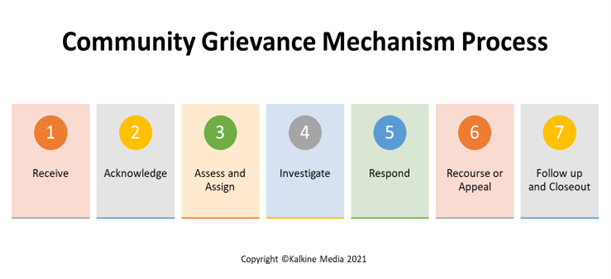What is Community Grievance Mechanism?
Community Grievance Mechanism (CGM) is a systematic complaint process used by communities that are negatively affected by the operations and activities of a business. It helps the companies and the adversely impacted individuals or community to resolve the issues using a non-judicial procedure.
Some companies also use the term ‘Feedback Mechanism’ in place of Grievance Mechanism.
CGM enables the neighboring communities to raise their voices in identifying and preventing potential risks. Mostly CGMs are beneficial if introduced at the early stage of the project. An effective CGM enables building trust, goodwill and teaches how to prevent a recurrence.

What is the Community Grievance Mechanism procedure?
The procedure to address the community’s complaints can vary for each country. The CGM procedure can be characterized into steps starting from receiving the complaint to closing with a resolution.
- Receive: The grievances will reach the concerned management only if the locals or impacted society are aware of any such mechanism. The companies must provide multiple access points to the complainants through the company website, in-person, letters, email, complaint boxes, customer helpline number, etc.
While designing the access points, the practitioner should ensure there are minimum barriers (like language or culture). The identity of the complainant should remain anonymous or confidential and the remaining steps should be explained, and the timeline related to it.
- Acknowledge: A receipt of formal acknowledgement is necessary to eliminate the false assumption of the complainant, whether the complaint is in process or ignored. This formal acknowledgement can be in the form of an SMS, email, verification call or a copy of the complaint form.
The companies should also encourage the complainants to ask for acknowledgement as good practice.
- Assess and assign: Once the complaint is registered in the system, it is advised that the grievance practitioner should rate it according to the risk to the company. If the complaint is rated as less risky, at times, the practitioner is authorized to investigate and close the complaint as soon as possible. On the other hand, if the complaint requires expertise, it is further escalated to the correct department.
- Investigate: An officer from the related department is appointed to take up the investigation process if the complaints are technical and require an in-depth investigation to support a resolution. The investigators or any third-party facilitators should meet the complainant to address the issue personally. In the investigation process, all the facts should be gathered in a documented form to establish a company response and the analysis performed. Throughout this process, a progress report should be shared with the complainant.
- Respond: To build trust in such mechanisms, it becomes crucial to respond to the complaints in a timely manner. The proposed resolution should be documented properly to avoid any confusion later. Also, the response should be in line with human rights standards and include the root cause to prevent any future recurrence. A delay in response could turn into another grievance.
- Recourse or appeal: It is advisable to include an alternative or appeal mechanism if the complainant does not reach a final agreement. It can be taken up by a third party if the complainant feels the outcome was biased. There are in-house teams as well to deal with these appeals.
- Follow-up and closeout: This is the final stage to implement the agreed resolution. Before closing the complaint, it is advisable to take the complainant’s signature on the complaint closure agreement to avoid future problems. A follow-up can help in refining the mechanism and can help in dealing with similar grievances.
Summary
- Community Grievance Mechanism is a systematic complaint process used by communities negatively affected by operations and activities of a business.
- The general procedure to address the complaints begins from receiving and acknowledging the complaint to following up and closing the complaint.
- It helps in improving the company-community relationship.
Frequently Asked Questions (FAQs)
- Why is community grievance mechanism considered a good investment in the company?
An effective CGM can help in dealing with the community’s grievances arising from daily operations. By exhibiting the willingness to take up society’s concerns, it strengthens the social relationship of the company. It also helps in saving the project’s cost if the grievance is addressed at the early stage.
Though CGM involves a lot of the company’s resources in terms of manpower and money, if the grievances are left unaddressed, they can become challenging and later will have to be solved through litigation, which is even more costly.
- What are the advantages and limitations of having a CGM in place?
Advantages:
- It prevents or refines harmful business activities.
- It helps in increasing public awareness about the implications of business activities.
- It helps in the formulation of better business practices and policies.
- It helps in formulating business standards for addressing similar grievances in the future.
Limitations:
- Time-consuming while resolving the complaints.
- The effectiveness of the CGM is dependent on the company’s inclination towards the process.
- The process of registering the complaint is time-consuming.
- Once the complaint is closed, there is no guarantee that the company will not repeat this behavior.
What are the important elements a CGM must have?
- There should be a transparent registering and acknowledging process so that the complainant can confirm if the complaint has been received or not. Also, it will help in monitoring the process.
- An eligibility assessment to decide if the complaint falls within the mechanism or if formulation of a new set of rules is required.
- The company should offer several choices to solve the grievance, like an internal team or a third party.
- The community’s feedback acts as an information system to improve the grievance handling process and business activities.
 Please wait processing your request...
Please wait processing your request...